| Conservation of the Jaffa Gate |

|
The Jaffa Gate section, between Jaffa Gate and the northwestern corner of the city walls (Zahal Square), was constructed on top of the eastern bank of the Ben Hinnom Valley. On the inside of the wall are buildings belonging to the Latin Patriarchate and College des Freres. This segment of the wall can be easily seen from Yemin Moshe neighborhood and Mamilla, from King David Street and the Wall Builders Garden.
Physical Data
There are fourteen segments c. 285 meters long in the Jaffa Gate section. The outside of the city wall is c. 13 meters high and the towers reach a height of c. 14 meters. In this section the wall's exterior facade covers an area of approximately 4,205 square meters. The elevation of the city wall at the northwestern corner of the section is c. 782.70 meters above sea level.
Conservation Values
Historical Values. The different changes that have taken place over the course of time are reflected in the Jaffa Gate section. Remains of ancient city walls from the Hasmonean period and the Ayyubid period are incorporated in the Ottoman city wall. In addition, one can see signs of where the Late Ottoman buildings were attached to the outside of the city wall.
Fortifications from the Jordanian period, which were hastily built of concrete and fieldstones, were preserved and they constitute a tier in the history of the city wall monument. A last memory dating from the War of Independence is apparent on the wall, in the wake of which numerous bullet holes were left around the firing slits and crenellations. These are evidence of the fierce battles that took place there during that conflict.
Urban Values. The location of the Jaffa Gate section, which faces west in the direction of the New City, and its considerable height relative to its surroundings, have created a high level of visibility. This section is a traffic route that is busy all hours of the day, thanks to Jaffa Gate, which serves as an entrance to the city from the west, used by both vehicles and pedestrians.
Architectural Values.The skyline of the Jaffa Gate wall is visible in its entirety and was preserved due to its considerable height. The towers in this section appear at set intervals. The Ottoman city wall was built on top of previous walls with meticulous technology, whereas the coarsely finished construction of the Ayyubid wall is characterized by the use of crudely dressed stone fragments. The Ottoman wall above it is distinguished by its delicate stone dressing and thin joints.
Physical Problems
The level of preservation along the section was not uniform. Since 1967 the Jerusalem municipality and Department of Antiquities have treated the city wall numerous times. In the lower parts of the wall the joints were pointed up with cement. This standardized manner of intervention covered up the technological differences between the different periods of the wall.
The state of preservation on the inside of the wall is reasonable, except in places where the intervention was unsuitable. It was apparent that capers have taken root in the wall's crenellations; a railing that had been installed at the time of the British Mandate caused significant cracking in the stone; on the outside of the wall there was massive stone deterioration as a result of a fire in the region where nearby buildings once stood.
Conservation Issues in Jaffa Gate
Numerous changes have been made to Jaffa Gate over the years, especially in the Late Ottoman period. In the early twentieth century later building additions were dismantled, including the clock tower, the sabil and the structures that were erected alongside the wall. The later changes to the gate include filling in the moat and breaching an opening in the wall for a passage leading directly into the city. Furthermore, the War of Independence should be mentioned which left its mark in the gate facades in the form of rifle bullets that struck the stonework in the gate.
In carrying out the conservation work on the gate we were asked to emphasize the architectural values of the Ottoman gate while conserving the historical value, embodied by the effects left by the changes in recent generations.
The architectural-historical values of the gate are embodied, among other things, in the inscriptions appearing on its facades. These values were reinforced by the conservation of the inscriptions that have suffered from significant weathering, and have been emphasized (Figs. 3, 4).
The historical value has been emphasized by means of conserving the marks made when the wall was breached in the southern facade of the gate, as well as the manner in which the bullet damage to the gate's stone work was treated. In this intervention we were asked to preserve the bullet holes and to slow down the weathering processes occurring in their wake. In this instance we were required to find a balance between the need for constructive stabilization and the desire to preserve the appearance of the damage caused by the bullets.
The Conservation Measures
Conservation of the Stone and the Treatment of the Bullet Holes.The stones that were damaged as a result of the bullets were stabilized and the stonework was completed by re-pointing the joints with mortar. The stone conservation measures included completion of the stonework utilizing stone and lime-based mortar, and reinforcing it by means of stainless steel pins.
Pointing up the Joints.The empty stone joints were cleaned of any remnants of crumbling mortar and re-pointed with lime-based mortar.
The Gate's Interior. The conservation action in the gate's interior included cleaning by means of soda flakes, stone conservation and pointing up the joints (Figs. 5, 6).
Installation of Anchors.. A massive fissure in the center of the gate's interior and the development of a crack in a firing slit above the opening of the gate were stabilized by means of installing stainless steel anchors.
The Gate's Inscriptions. The intervention included: documenting the inscription field, its state of preservation and analysis, restoring a uniform color to the stone and highlighting the written letters in order to improve their legibility. While working on the main inscription above the opening of the gate in the northern facade a large cavity was discovered behind the inscription's stones. This resulted in taking the inscription down and transferring it to the conservation laboratory in the Rockefeller Museum for treatment by conservators. After filling in the cavity the inscription was returned to its original place above the opening.
|
|
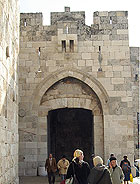
|
| 1. The entrance facade prior to conservation, 2009. Photograph: Yuval Abraham. |
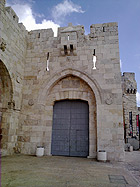
|
| 2. The entrance facade after conservation, 2009. Photograph: Yuval Abraham. |
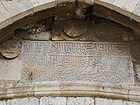
|
| 3. The inscription field prior to conservation, 2009. Photograph: Yuval Abraham |
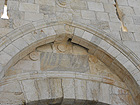
|
| 4. The inscription field after conservation, 2009. Photograph: Yuval Abraham. |
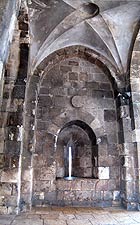
|
| 5. The inside of the gate prior to conservation, 2009. Photograph: Yuval Abraham. |
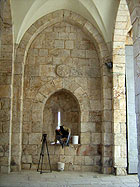
|
| 6. The inside of the gate after conservation, 2009. Photograph: Yuval Abraham. |
|















